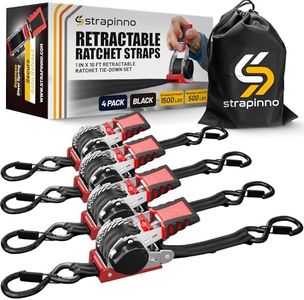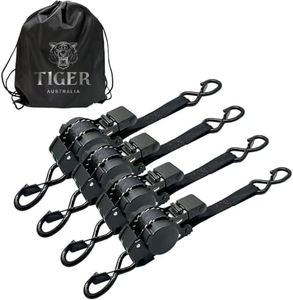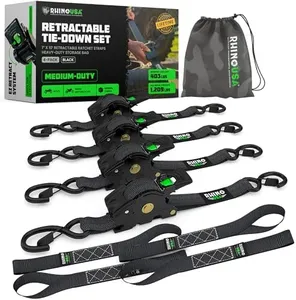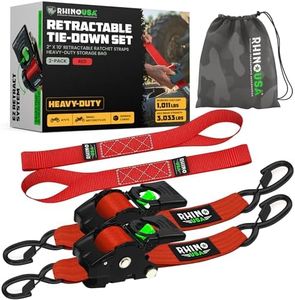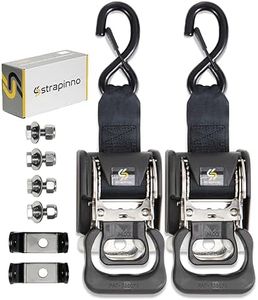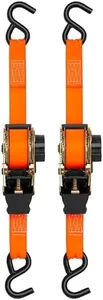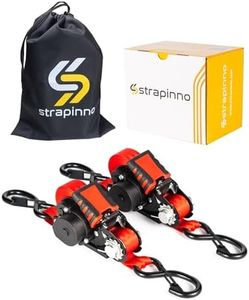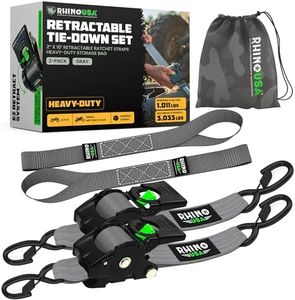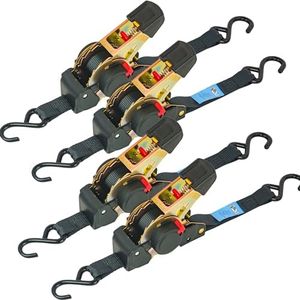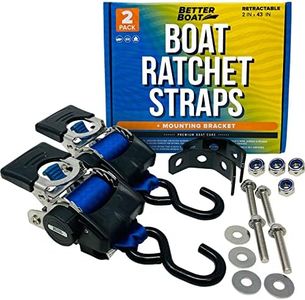We Use CookiesWe use cookies to enhance the security, performance,
functionality and for analytical and promotional activities. By continuing to browse this site you
are agreeing to our privacy policy
10 Best Retractable Straps
From leading brands and best sellers available on the web.Buying Guide for the Best Retractable Straps
When choosing retractable straps, it's important to think about how and where you'll use them. Retractable straps are convenient for quickly securing loads, gear, or belongings because they can be easily wound up and stored. Picking the right retractable strap ensures your items stay safe and makes your job much easier. Before buying, consider what you'll be securing, how often you'll use the strap, and the environments you’ll use it in.Load Capacity (Working Load Limit)This spec tells you how much weight the strap can safely hold while in use. It's crucial because using a strap with less capacity than you need could lead to breakage and damage to your items or injury. Straps often come with labels indicating their safe working limit—commonly ranging from a few hundred pounds for light uses up to several thousands for heavy-duty tasks. For small boxes or personal items, lower limits are fine, but for securing heavier equipment or large loads, always choose a strap rated for more than your heaviest expected load. It’s best to pick a strap that has a working load limit higher than what you plan to carry, to ensure safety.
Strap LengthStrap length refers to how long the strap is when fully extended, which determines the size of items or surfaces you can secure. Shorter straps (around 6-8 feet) are suited for smaller items or close tie-down points, while longer straps (up to 20-30 feet or more) are better for larger cargo, roof racks, or truck beds. Picking the right length depends on the typical size of the loads or the space between anchor points. For general use, a medium-length strap offers flexibility, but for specific needs (like moving furniture or bikes), measure the space you need to cover before choosing.
Strap MaterialMost retractable straps are made of polyester or nylon webbing, each with its strengths. Polyester is commonly used because it resists stretching and handles outdoor exposure well, making it durable in sunlight and wet conditions. Nylon is a bit stretchier, which can help cushion loads but may not be as resistant to UV and moisture over time. The choice comes down to the type of loads and environments you expect; those needing long-term outdoor use or resisting weather should opt for polyester, while those needing slight give might consider nylon.
Retracting Mechanism QualityThe retracting mechanism is what allows the strap to wind back into its case for tidy storage. A smooth, reliable mechanism prevents tangles, makes setup faster, and keeps the strap in good condition. Better mechanisms feel smooth and are less likely to jam or wear out quickly. If you expect frequent use, try to select a mechanism that feels sturdy and is made with quality materials—look for reviews or feedback about ease of use. Less frequent users can sometimes get by with simpler designs, but a well-made mechanism saves frustration in the long run.
End Fittings (Hooks/Clips)End fittings are the parts that attach the strap to an anchor point, such as S-hooks, snap hooks, or clips. The right type depends on what you're attaching to—S-hooks are very versatile for most general tie-downs, while other fittings may offer more security for specific anchor points. You should also consider the strength and construction of these fittings, especially if handling heavy loads. Make sure that the end fittings are compatible with your anchor points and can withstand the required force.
Ease of UseThis covers how simple it is to operate the strap—extending, tightening, and retracting it. Comfortable, reliable handles or release levers make the difference, especially if you use them often or in a hurry. Some mechanisms are designed for fast, one-handed operation. If you'll use retractable straps often or want to avoid hassle, prioritize designs that are well-reviewed for user-friendliness.
